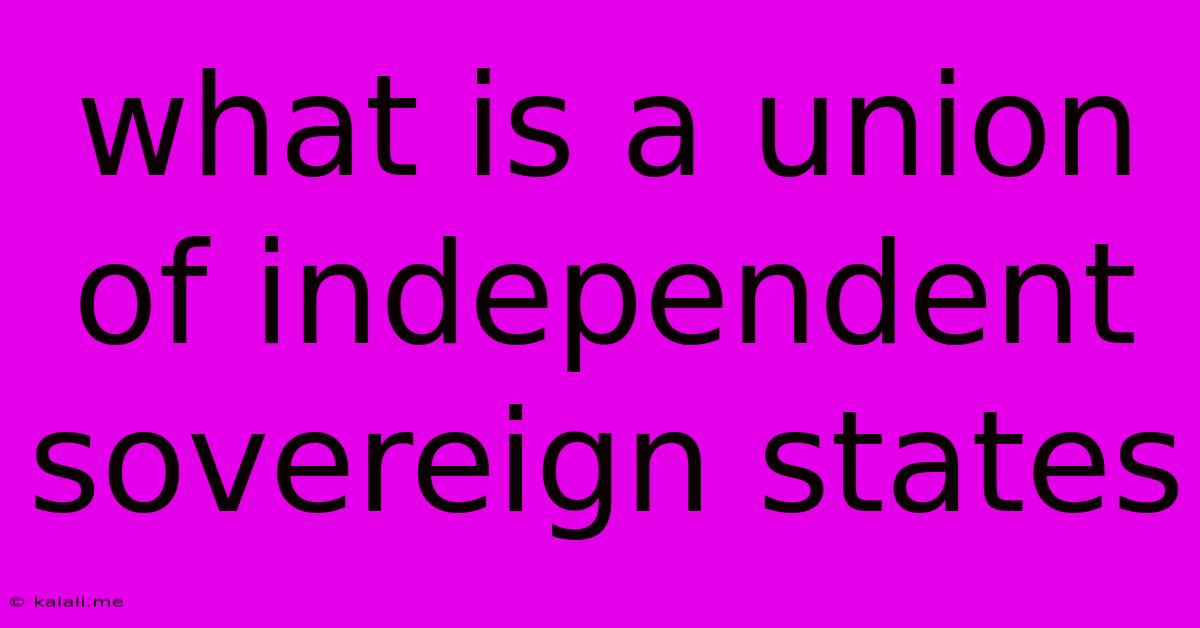What Is A Union Of Independent Sovereign States
Kalali
Jun 12, 2025 · 3 min read

Table of Contents
What is a Union of Independent Sovereign States? Navigating the Complexities of Federalism
A union of independent sovereign states, often referred to as a federal state or federation, is a complex political entity characterized by a sharing of power between a central government and several constituent units (states, provinces, or regions). This arrangement differs significantly from a unitary state, where power is concentrated at the national level, and a confederation, where individual states retain greater autonomy. Understanding the nuances of this structure requires examining its key characteristics and challenges. This article delves into the definition, characteristics, advantages, and disadvantages of a union of independent sovereign states.
Defining a Union of Independent Sovereign States:
At its core, a union of independent sovereign states involves a voluntary agreement among previously independent entities to pool some of their sovereignty while retaining significant autonomy in certain areas. This "pooling" of sovereignty is enshrined in a constitution, which outlines the powers and responsibilities of both the central government and the constituent units. The central government typically handles matters of national importance, such as defense, foreign policy, and currency, while constituent units manage local affairs, like education, healthcare, and law enforcement. The exact division of powers varies significantly between different federations, influenced by historical context, cultural diversity, and political landscapes. Examples include the United States of America, Canada, Australia, the European Union (although arguably more of a supranational entity), and India. Each of these displays a unique balance of power between the central government and the member states.
Key Characteristics of a Federal State:
- Division of Powers: A clear, constitutionally defined separation of powers between the central government and the constituent units. This often involves a system of checks and balances.
- Shared Sovereignty: Both the central government and the constituent units possess significant sovereignty, but the extent of this sovereignty is defined by the constitution.
- Multiple Levels of Government: A hierarchical system involving a central government and multiple layers of regional or local government.
- Constitutional Supremacy: The constitution serves as the supreme law of the land, defining the relationship between the central government and the constituent units.
- Representation: The constituent units typically have representation in the central government, often through a bicameral legislature.
- Judicial Review: An independent judiciary often plays a critical role in resolving disputes between the central government and the constituent units.
Advantages of a Union of Independent Sovereign States:
- Protection of Regional Interests: Allows different regions to maintain their unique identities and cultures while benefiting from the strength of a unified nation.
- Enhanced Efficiency and Effectiveness: Centralized control over certain crucial areas like national defense and foreign policy can lead to greater efficiency.
- Increased Political Stability: By distributing power, federal systems can be more resilient to political upheaval and instability compared to unitary systems.
- Economic benefits: A larger market can create greater economic opportunities and trade facilitation.
- Experimentation and Innovation: Different states or provinces can experiment with different policies and approaches, providing opportunities for innovation and learning.
Disadvantages of a Union of Independent Sovereign States:
- Complexity and Inefficiency: The multiple layers of government can lead to bureaucratic complexity and inefficiencies.
- Potential for Conflict: Disputes between the central government and constituent units can arise over the division of powers.
- Unequal Resource Distribution: Wealth and resources may be unevenly distributed between constituent units, creating regional imbalances.
- Lack of Uniformity: Differences in policies and regulations between constituent units can create complications for businesses and individuals.
- Risk of Secession: In extreme cases, strong regional identities can lead to calls for independence and secession.
Conclusion:
A union of independent sovereign states offers a complex but potentially effective model for governing diverse populations and territories. While it presents several advantages, including the protection of regional interests and enhanced political stability, challenges associated with complexity, potential conflicts, and resource distribution must be carefully managed. Understanding the unique characteristics and trade-offs involved is crucial for navigating the intricacies of this important form of government. The success of a federation ultimately depends on the willingness of its constituent units to cooperate and compromise, upholding the principles of shared sovereignty and constitutional supremacy.
Latest Posts
Latest Posts
-
Difference Between Rhombus And A Square
Jun 13, 2025
-
Choose The Correct Option To Complete The Sentences
Jun 13, 2025
-
How To Ask For Compensation For Inconvenience
Jun 13, 2025
-
Polar Moment Of Inertia For Hollow Shaft
Jun 13, 2025
-
Is Swift Code And Ifsc Code Same
Jun 13, 2025
Related Post
Thank you for visiting our website which covers about What Is A Union Of Independent Sovereign States . We hope the information provided has been useful to you. Feel free to contact us if you have any questions or need further assistance. See you next time and don't miss to bookmark.